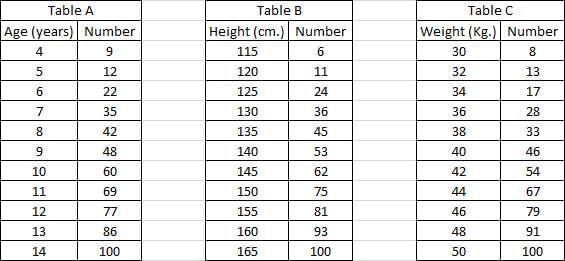Practice Question - 69 (Connected Data Sets) | 100 DILR Questions for CAT Preparation PDF Download
Directions for the following three questions:
Answer the questions on the basis of the information given below.

Table A below provides data about ages of children in a school. For the age given in the first column, the second column gives the number of children not exceeding the age. For example, first entry indicates that there are 9 children aged 4 years or less. Tables B and C provide data on the heights and weights respectively of the same group of children in a similar format. Assuming that an older child is always taller and weighs more than a younger child, answer the following questions.
Q1: What is the number of children of age 9 years or less whose height does not exceed 135 cm?
(a) 48
(b) 45
(c) 3
(d) Cannot be determined
 View Answer
View Answer 
Ans: (b)
Number of children of age 9 years or less are 48 and those whose height does not exceed 135 cm are 45 . 45 is lesser, hence answer is 45.
Q2: How many children of age more than 10 years are taller than 150 cm and do not weigh more than 48 kg?
(a) 16
(b) 40
(c) 9
(d) Cannot be determined
 View Answer
View Answer 
Ans: (a)
There are 40 children of age more than 10 years and 25 children that are taller than 150 cm. Considering 25 which is less than 40 . Also there are 9 children whose weight is more than 48 kg. Hence there are 25-9 = 16 children whose weight will bw less than 48 kg and all other requirement.
Q3: Among the children older than 6 years but not exceeding 12 years, how many weigh more than 38 kg.?
(a) 34
(b) 52
(c) 44
(d) Cannot be determined
 View Answer
View Answer 
Ans: (c)
Number of children older than 6 years but not exceeding 12 years are 55 and number older than 12 years are 23 . Also children weighing more than 38 kgs are 67. Out of these 67 , 23 will have age more than 12 . Hence we have 67 - 23 = 44 childrens will the given requirement. Hence option (c).
|
102 videos|123 docs|121 tests
|




















